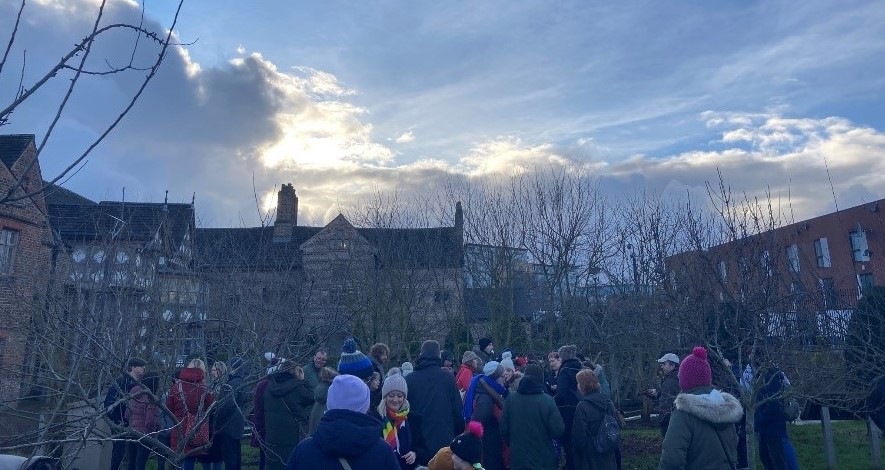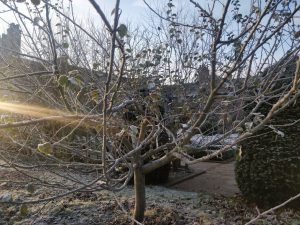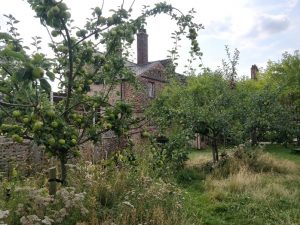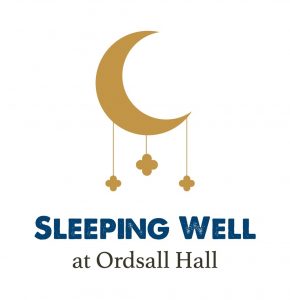
Sleep and Apples: Wassailing and Apple Moyse Making
Every January, Ordsall Hall celebrates Twelfth Night with the blessing of the apple trees in the orchard. This date would have been 5th January before the English calendar changed in 1752. At Christmas it was traditional to celebrate festivities with wassail, a spiced apple drink using cider and spices. Twelfth Night, the 12th day of Christmas, was the last night of celebrations and marked the Epiphany on the coming of the three kings to see Jesus. The Ordsall wassail recipe is here for those who want to replicate it:
Ingredients:
2.5 litres/4.5 pints Apple juice (or cider for alcoholic version)
3 whole apples
1 whole orange
Teaspoon whole cloves
½ teaspoon ground nutmeg
½ teaspoon ground ginger
2 Cinnamon sticks
Method:
Add all the ingredients to a large pan and heat gently for 45 mins. Alternatively, you can use a slow cooker and heat on low for 2 hours. You can also bake the apples in the oven beforehand for 45 mins on 200C or gas mark 6 and then warm the apple juice/cider through on the hob with the spices.
This would be shared amongst guests and the local community in a ritual similar to trick or treating. However, wassailing served another purpose towards the end of the festive season. It was used to bless the apple trees in January to ensure a good harvest nine months later in September.

Wassail day 2023 at Ordsall Hall’s orchard. Photos: Annie Love
Dr Leah Astbury from the Sleeping Well research team highlights the following advice from 1670 which featured several orchard fruits – apples, quinces, and pears:
‘These procure quiet sleep, Violets, Lettuce, especially boiled, Sirrup of dried Roses, Saffron, Balm, Apples, at our going to bed; a sop of Bread in Malmsey, especially where Musk-Roses have been first infused: therefore it would not be amiss to make some Pill, or small Draught of these things, and to use it familiarly. Also those things which shut the mouth of the stomach close, as Coriander-seed prepared, Quinces and Wardens roasted, do induce sound sleep; but above all things in youth, and for those that have sufficient strong stomacks, it will be best to take a good draught of clear cold Water when they go to bed’,
Francis Bacon, Sylva Sylvarum (1670), p. 33.
Apples can also be found in modern sleep remedies such as the various sleepy teas on the market. This is because apples contain tryptophan which in turn prompts the production of the sleep hormone melatonin. Apples are also rich in vitamins C and B6 which are known to help us sleep. However, some fruits before bed can be counter-productive due to the amount of natural sugars they contain. Early modern people would not think of apples and sleep in this way. The Sleeping Well project aims to reveal the similarities and differences between early modern explanations of sleep, the body, and environment and modern-day understandings of these links. Early modern knowledge connected sleep with digestion and apples could be problematic in this respect.

Wassail day 2023 at Ordsall Hall’s orchard. Photos: Annie Love
As part of the Sleeping Well project’s use of sleepy ingredients at Ordsall Hall, Anna Fielding has been exploring apple recipes. The use of apples for sleep in early modern times was approached with caution as apples (as with most other fruit) were classified as watery and cold, properties which were believed to lead to digestive problems which could hamper sleep. During the winter months, wet and cold (phlegmatic) conditions plus the consumption of wet and cold (phlegmatic) ingredients ran the risk of upsetting a person’s humoral balance and bringing discomfort, ill health, and disrupted sleep. To ward against this, apples and other watery fruits needed to be consumed with dry and hot (choleric) spices to balance them out, as well as being cooked to help warm and dry out their phlegmatic nature. Health advice throughout the year stipulated that spices were vital in the winter as they maintained the body’s heat during cold weather. Many spices were also known for their sleepy properties, as they helped to regulate digestion through warming and sealing the stomach, which in turn aided sleep’s onset. The combination of warmed apples and spices was an ideal dish to serve in January. Together with the annual wassailing celebration at Ordsall Hall, it was the perfect time of year to try out an apple dish.
Before the annual blessing ritual in the orchard Anna set about making apple moyse with visitors.
To Make an Apple Moyse:
Take a dozen apples and ether rooste or byle [boil] them and drawe them thorowe a streyner [strainer], and the yolkes of three or foure eggs withal, and, as ye streyne them, temper them wyth three or foure sponefull of damaske water [rosewater] yf ye wyll, than take and season it wyth suger and halfe a dysche of swete butter, and boyle them upon a chaffyngdysche [a pan] in a platter, and caste byskettes [biscuits] or synamon [cinnamon] and gynger upon them and so serve them forth.
Anon, A Proper Newe Book of Cokerye, c.1572.
For a modernised version:
Ingredients:
6 apples
Two egg yolks
2 tbls rosewater
2 tbls sugar
25g butter
½ tsp ground cinnamon
½ tsp ground ginger
Method:
Cook the apples in a pan with a little water, as you would if making stewed apples. Blend to a pulp and return to the pan and stir in the egg yolks mixed with the rosewater, sugar, and butter. Heat slowly and stir continuously until the mixture thickens into a curd. Place in a dish and sprinkle with cinnamon and ginger.
The recipe resulted in a curd-like pudding which felt warm and soothing, perfect for a wet and cold January. An ideal way of serving this to avoid too much sugar before bed would be on a slice of wholemeal toast. Fruits that are scientifically proven to help with sleep before bed according to The Sleep Charity are cherries and bananas. Tart cherries are best as they boost the body’s melatonin levels. Bananas are another good choice as they contain magnesium, potassium, and tryptophan which all aid sleep. The apple moyse recipe can be adapted by substituting the apples for ripe bananas.
The moyse recipe will form part of the sleeping well project’s Ordsall recipe book, which we will be adding to over the next two years alongside more historical and modern-day sleep aids. More cooking and remedy making will take place throughout 2023 and 2024 as we continue to explore the connections between sleep, food, gardens, health, and the early modern home.
Further Reading:
Handley, S. Sleep in Early Modern England. Yale (2016)









0 Comments